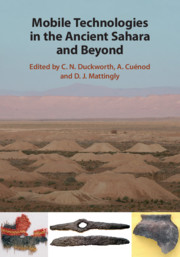Book contents
- Mobile Technologies in the Ancient Sahara and Beyond
- The Trans-Saharan Archaeology Series
- Mobile Technologies in the Ancient Sahara and Beyond
- Copyright page
- Contents
- Figures
- Tables
- Contributors
- Preface
- Part I Introduction
- Part II Technological Mobility and Transfers
- Part III Metallurgy
- 7 Metalworking in Pre-Islamic North Africa
- 8 Is the Archaeometallurgical Record a Valuable Tool when Considering Meroe within a Trans-Saharan Landscape?
- 9 What Is the Meaning of the Extreme Variability of Ancient Ironworking in West Africa?
- Part IV Glass Technology
- Part V Handmade Pottery
- Part VI Conclusion
- Index
- References
7 - Metalworking in Pre-Islamic North Africa
A View from the Garamantian Oases
from Part III - Metallurgy
Published online by Cambridge University Press: 18 September 2020
- Mobile Technologies in the Ancient Sahara and Beyond
- The Trans-Saharan Archaeology Series
- Mobile Technologies in the Ancient Sahara and Beyond
- Copyright page
- Contents
- Figures
- Tables
- Contributors
- Preface
- Part I Introduction
- Part II Technological Mobility and Transfers
- Part III Metallurgy
- 7 Metalworking in Pre-Islamic North Africa
- 8 Is the Archaeometallurgical Record a Valuable Tool when Considering Meroe within a Trans-Saharan Landscape?
- 9 What Is the Meaning of the Extreme Variability of Ancient Ironworking in West Africa?
- Part IV Glass Technology
- Part V Handmade Pottery
- Part VI Conclusion
- Index
- References
Summary
This chapter first reviews the evidence for metal and metalworking recovered in Fazzan (Libyan Sahara) and presents the results of an analytical program carried out by the Trans-SAHARA Project. This evidence is then considered in relation to other Saharan, North African and West African sites dating from a similar period. The Garamantes seem to have used both copper alloys and iron for ornamental as well as utilitarian purposes. Chemical analysis of the copper-base fragments indicates that at least part of the metal was imported from the Roman world. However, the recovery at Garamantian sites of a certain amount of metalworking debris (slag, hearths and ingot moulds) dating to the second half of the first millennium BC to the beginning of the first millennium AD, shows that metal was also worked and transformed in the oases. Moreover, evidence for trade and possible shared technological choices between Fazzan and sites on the southern edge of the desert is starting to emerge. These choices would have been influenced by environmental constraints such as the scarcity of fuel and copper ores and impacted by the entanglement of metallurgy with other technologies such as agriculture.
- Type
- Chapter
- Information
- Mobile Technologies in the Ancient Sahara and Beyond , pp. 211 - 258Publisher: Cambridge University PressPrint publication year: 2020
References
- 1
- Cited by

